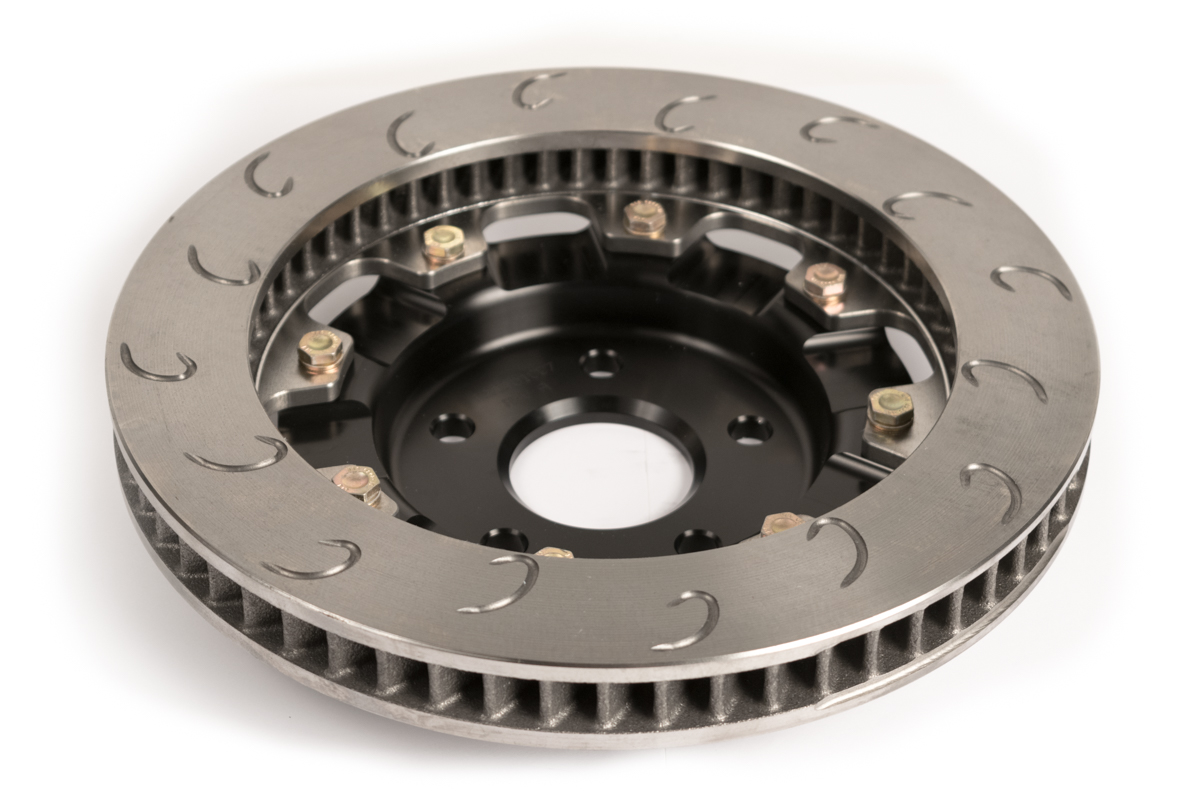- Regular price
- $2,499.00
- Regular price
-
- Sale price
- $2,499.00
- Unit price
- per
30 day returns
Free Shipping
Free standard shipping on orders over $99
Coupon Code on First Order
Price Match Guarantee
Free shipping on $99+ order
30-days Returns
Complete front Essex Designed AP Racing Competition Brake Kit for Subaru BRZ / Scion FR-S / Toyota GT86
- Features AP Racing CP8350 four piston calipers
- 299x32mm, 60 vane AP Racing disc
- Saves 20 unsprung lbs. from nose of vs. OEM brakes
- Every component designed to resist the heat of extended track sessions
- Pistons sized properly to allow for seamless integration with OEM master cylinder and ABS system
- Designed to work with OEM rear brakes
WHAT'S IN THE BOX?
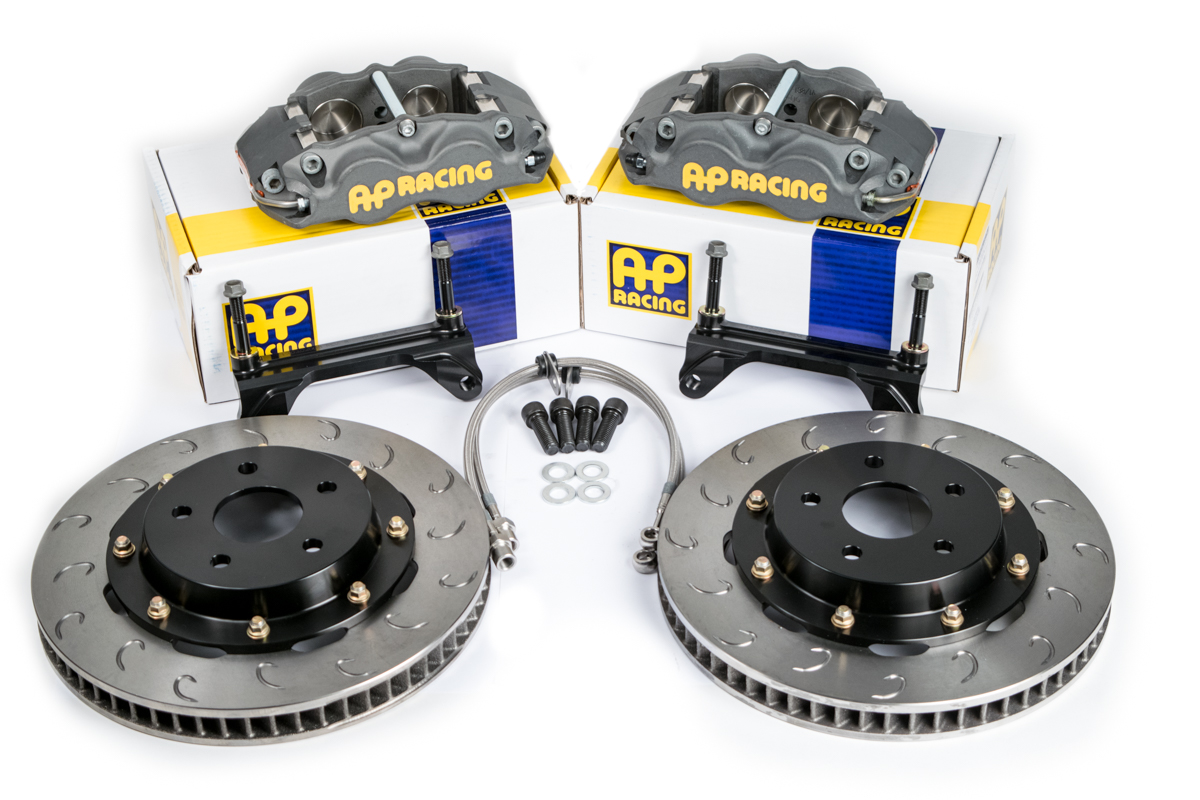
- One pair AP Racing CP8350 racing calipers
- One pair 299x32mm AP Racing, 60 vane, J Hook racing discs, with 6061 hard anodized aluminum hats, and attachment hardware
- One pair caliper mounting brackets and hardware
- One pair Spiegler Stainless Steel Brake Lines with abrasion resistant coating
- Detailed installation instructions
- Brake pads are NOT included with our system. Racing brake pads are a highly personal choice. Many manufacturers include a set of inexpensive, low quality pads with their brake kits. Rather than artificially inflating the price of our system with a set of pads you probably don't want anyway, we've decided to remove the cost from our system and allow our customers to choose the pads that best suit their needs/wants. When purchasing our kit, you are able to choose one set of front pads at a substantial discount vs. the retail price. Please use the drop-down menu to select your pads.
CALIPERS
CP8350
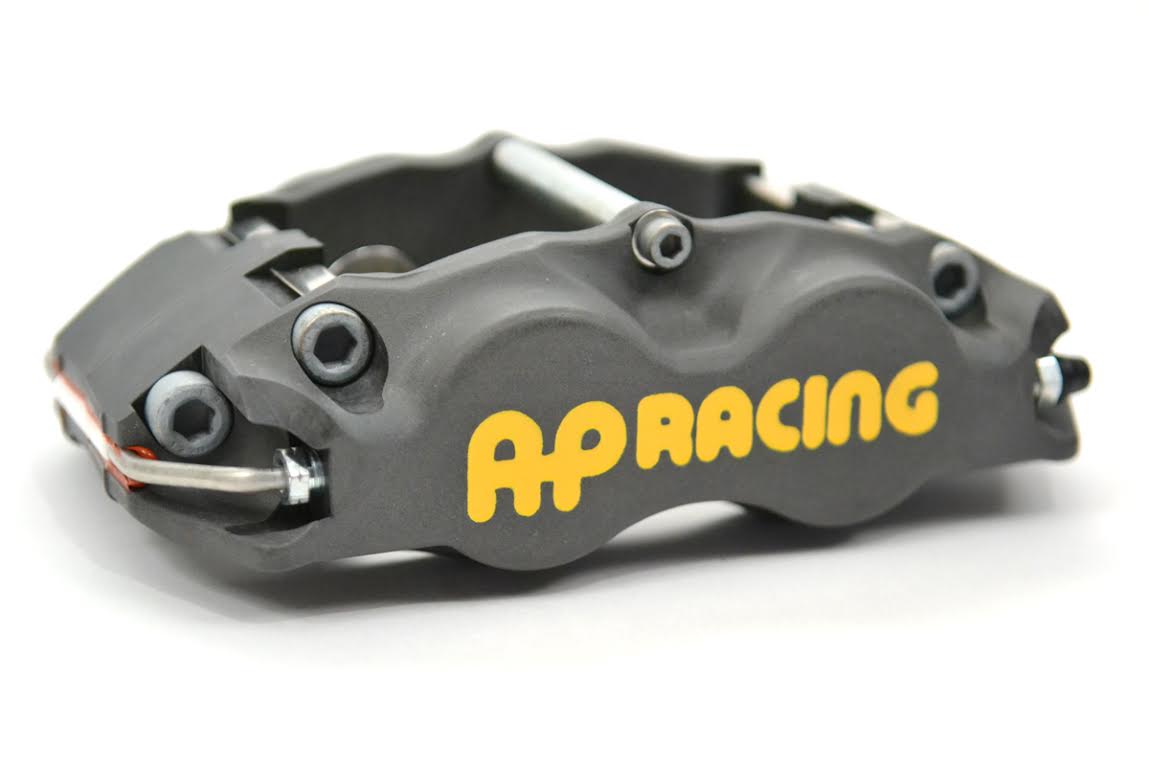
Hard Anodized Finish
The first obvious weakness when looking at a typical aftermarket caliper is the finish. Most aftermarket calipers come in a painted finish, whether they are red, black, or gold. That painted finish is designed to look pretty and prevent corrosion in harsh winter environment. Unfortunately, for all of the compliments painted calipers generate, there is an associated price if you drive the car in a track environment. That price is the chipping, flaking, fading, color shift, and general degradation of that finish in a fairly short period of time. Some OEM calipers can go from the as-delivered color to a nasty shade of brown in as little as one weekend. While this is generally worn as a badge of honor among our more hardcore customers, let’s face it…they still look terrible. More importantly however, all of those bits of paint end up in places they’re not supposed to, which we’ll get to in a minute.
Why does this happen? Heat. Paint and powder coat cannot sufficiently handle track temperatures. Powder coat also has some notorious issues with shrinkage. The powder coat layer expands and grows when the caliper is heated. When it cools, the powder coat doesn’t necessarily shrink in step with the caliper body itself. What’s left is a loose shell of finish hanging limply on the caliper body. That shell then cracks and falls to pieces.
Paint can also have similar problems depending on how it is applied. If you were to line up a few aftermarket calipers from the same manufacturer, you would likely see that the painted finish on each of those calipers is a bit different. Some have a thicker coat, some thinner, slightly different shades of red, etc. Painting is to some extent an art form, and must be performed in a tightly controlled environment. If it isn’t, you’re always going to see variation. A thick coat makes the part look soft around the edges, and is prone to cracking off in the same manner as the powder coat described above, leaving the underlying finish exposed. A part without enough paint will look uneven, and will not protect the underlying aluminum particularly well either. In addition to problems with cracking, flaking, and uneven application, paint and powder coat also experience extreme color shift when heated. Red becomes maroon or black, gold becomes brown, and black just gets uglier.
The calipers we are using in the Essex Competition Kits are ultra-lightweight, stiff, and durable under all track conditions. The finish is a hard anodizing, which is the business under track conditions. When raw aluminum reacts with the oxygen in the air, a hard surface film develops on aluminum which prevents further degradation. The process is called oxidation, and you can think of it like rust. The anodizing process leverages this natural phenomenon, and takes it a step further to produce an extremely hard protective layer of aluminum oxide. It does so by running an electrical current through an acid bath, and dying it to the desired color. If you want to know more, Google it.
The outcome is a finish that is far more appropriate for racetrack use. Anodizing creates a uniform surface that is much more abrasion resistant than paint or powder coat. That means if you ding an anodized caliper with a box wrench when bleeding it, a big chunk of the finish isn’t going to chip off into your hand. While anodized calipers will still exhibit color shift, it will take a lot more heat to get them to change, and they won’t change as drastically. More importantly though, you aren’t going to have bits of anodizing sticking to the sides of your pistons.
20mm Thick Brake Pads in A Commonly Available Shape
Race pads aren’t cheap, and you burn through them quickly if you spend any amount of time on track. The average set of race pads for the AP Racing CP8350 costs approximately $175. How many sets of brake pads do you go through in a season? Some people find that they could pay off their brake system in a short period of time on pad savings alone. Not only are the pads for the CP8350 inexpensive, they’re also 20mm thick. That extra thickness acts as a thermal barrier and helps keep heat out of your pistons and brake fluid. Finally, since this pad shape is used by a wide range of racing calipers, it’s available in just about every popular racing compound on the market (Essex alone sells close to 20!). That means you’ll never end up in a pinch without pads. Cheap, thick, and available is a great combination for a consumable like race pads.
Below is a drawing of the basic pad shape used in the CP8350:
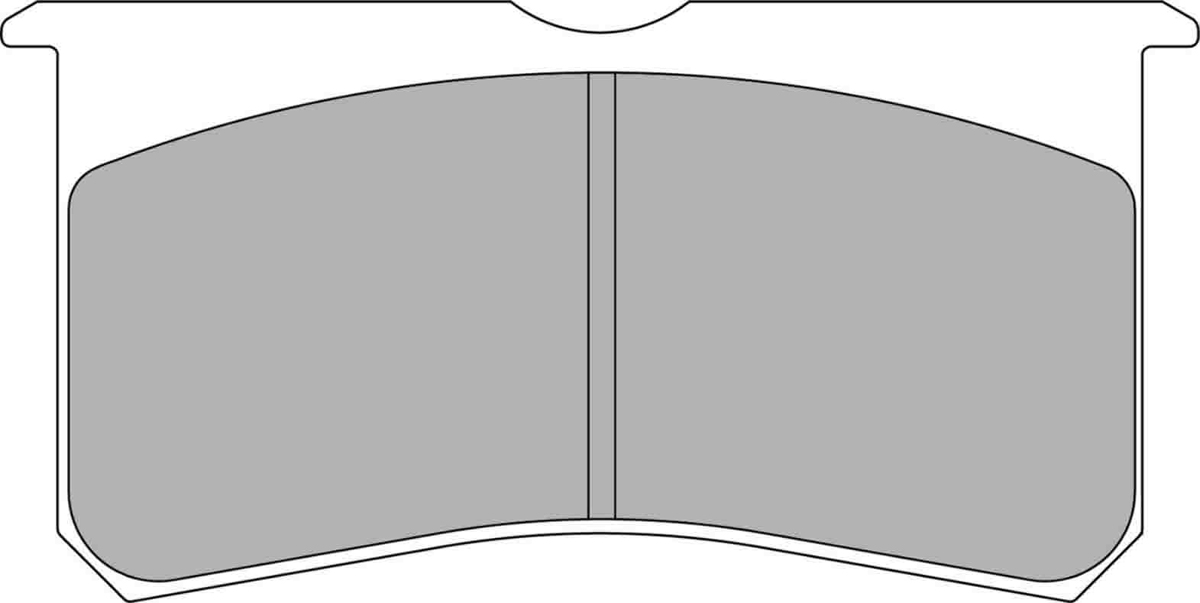
Dimensions= 133.2mm x 60.0mm x 20.0mm
The available pad compounds that Essex offers for the CP8350 caliper can be found below. Please note however, that the pad shape we use in our caliper is available in a variety of radial depths (heights). When combined with the CP3862 299x32mm disc, Essex recommends the D42-D43mm radial depth version. The other common radial depths in this pad shape are 50mm and 39mm. The 39 radial depth will fit into our caliper, but you will be leaving a small unswept 'ring' around the disc near the attachment points to the hat (the pad will not hang as low in the caliper). Leaving a portion of the disc face unswept can create a temperature differential across the face of the disc, and doing so could lead to premature disc cracking. That said, we have not run into such a problem with our kits in the field. The 50mm radial depth version will not work with our 299x32mm disc.
Pad compounds below are ranked from most aggressive to least aggressive.
Ferodo Racing
Pad Cross Reference
Again, please keep in mind that there are many other compounds available on the market from other manufacturers. Since we do not offer many of the brands listed below, Essex cannot guarantee the fitment of these pads in the AP Racing CP8350 caliper. Based on our research however, we believe that these are the appropriate cross references for the basic shape. Although, you should confirm with either the manufacturer or your installer prior to purchasing any of them.
|
D43 Depth |
D50 Depth |
|
|
Manufacturer |
Part Number |
Part Number |
|
Carbotech |
CTW7420 |
CTFRP3116 |
|
Circo |
MB1680 |
MB2660 |
|
Endless |
RCP106 |
RCP106 |
|
Ferodo |
FRP3097 |
FRP3116 |
|
Hawk |
HB521.800 |
NA |
|
Mintex |
2205 |
2206 |
|
Pagid |
2205USA |
NA |
|
PFC |
7751.xx.20 |
NA |
|
Project Mu |
999 |
NA |
|
Raybestos |
R701 |
NA |
|
Wilwood |
7420 |
NA |
Stainless Steel Pistons
There are people who will tell you that aluminum pistons are great for track calipers. They will tell you that the expansion rates of the pistons and caliper body need to be the same when heated. This argument is completely inaccurate and unproven. Those same people tend to get upset when you point out the fact that every serious race caliper, from every serious race caliper manufacturer on the planet uses either stainless steel or titanium pistons, period. There is a reason for this: they're much better!
While most aftermarket calipers use a pressed aluminum piston, the CP8350 uses an expensive machined stainless steel piston. Aluminum has a much higher thermal conductivity than stainless steel, and therefore transmits heat into your brake fluid much more quickly. That is exactly what you don't want! Stainless steel pistons are far superior to aluminum pistons in creating a thermal barrier. They help keep heat out of your brake fluid, preventing a soft pedal (brake fluid fade) on the track. This has been shown over and over again at all levels of motorsport.
Titanium pistons are a great option, but they are hideously expensive. Stainless steel offers the greatest balance of heat reduction, weight, and price. They also alleviate the need for crutch solutions such as fitting a titanium shim between the brake pad and highly conductive aluminum pistons
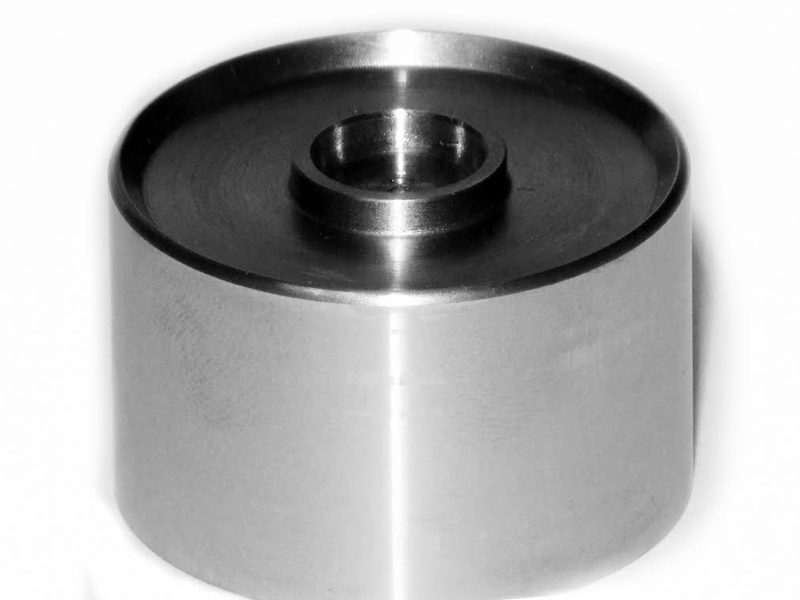
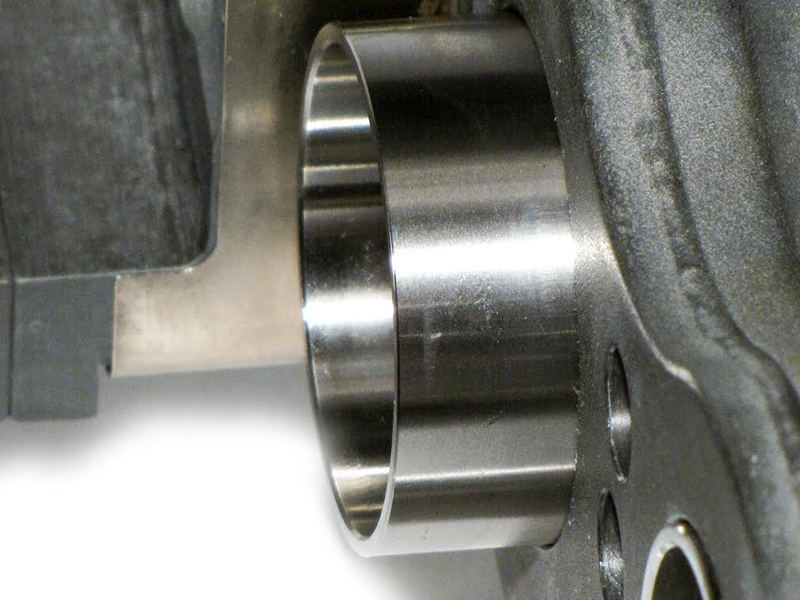
Anti-knockback Springs
Not only are the domed back pistons ventilated stainless steel, they are also fitted with anti-knockback springs. Springs behind the pistons you ask? Yes, springs. If you’ve ever gone through a series of S turns and then had your pedal drop when going into the following brake zone, you have experienced knockback. To say it is disconcerting is an understatement. You’ll often see pro drivers ‘pre-tap’ their brakes lightly when approaching a brake zone. They are fighting knockback.
Knockback is a phenomenon that is common with fixed calipers. Knockback happens when your car’s wheel, hub, and bearings deflect during cornering, allowing your brake disc to move out of sync with your caliper and brake pads. The caliper is less susceptible to movement because it is attached to the more rigid upright. As the brake disc deflects, it actually pushes the pads away from each other, forcing the caliper pistons back into their bores. The piston seals don’t have enough tension in them to return the pistons to their original location. That means there is slack in the system that needs to be taken up. When you press the brake pedal, it will resume to drop until that slack is taken up.
Anti-knockback springs help alleviate this situation by putting some tension on the back side of the pistons. When the disc deflects and makes contact with the pistons, the springs push the pistons back into their proper location, decreasing slack in the system. That means less pedal drop and far fewer pucker-factor moments when going into heavy brake zones.
There are no major downsides to lightweight AKB spring as long as the caliper is designed to accommodate them. More specifically, AKB springs do not create any increased drag or wear on the pads and discs as long as the shape and material of the piston seals takes them into account.
As you're driving the suspension is persistently compressing, the disc is moving around laterally, and the pads are being pushed slightly away from the disc. Think of the seals in the caliper as a spring or hinge attached to the side of the piston, rather than just a ring through which the piston slides. In an AP Racing competition caliper, the groove in which the seal resides isn't a square cut groove.It has angles. When the pistons slide in or out there is friction between the outer piston wall and the seal, and the seal distorts a bit as shown in the illustration below.
A caliper piston sliding out to the left would distort the seal in this manner (the slashes are the seals on either side of the piston):
/
---
---
\
As the piston slides back in to the right, the seal does this:
\
---
---
/
There is a definite amount of tension or friction that needs to be overcome before the piston actually starts moving through the seal ring. That tension/friction keeps the piston from dragging on the disc once the pistons are pushed back into the bores by the disc/suspension movement.
When AKB springs are added, a little more force is required to push the pistons back into their bores than would be needed without them. After the spring is compressed, it unloads and pushes the piston back to 'neutral.'
With the proper seal and spring the goal is to keep the piston in the 'neutral' position, not pressed against the disc. The piston is still able to slide freely in either direction, but a bit of friction or tension demands to be overcome initially to get it moving in either direction. The seal offers that first bit of friction to limit movement, and then the spring provides additional resistance. The end outcome is that the properly designed AP Racing calipers won't drag or create additional or unnecessary wear, despite having springs behind the pistons.
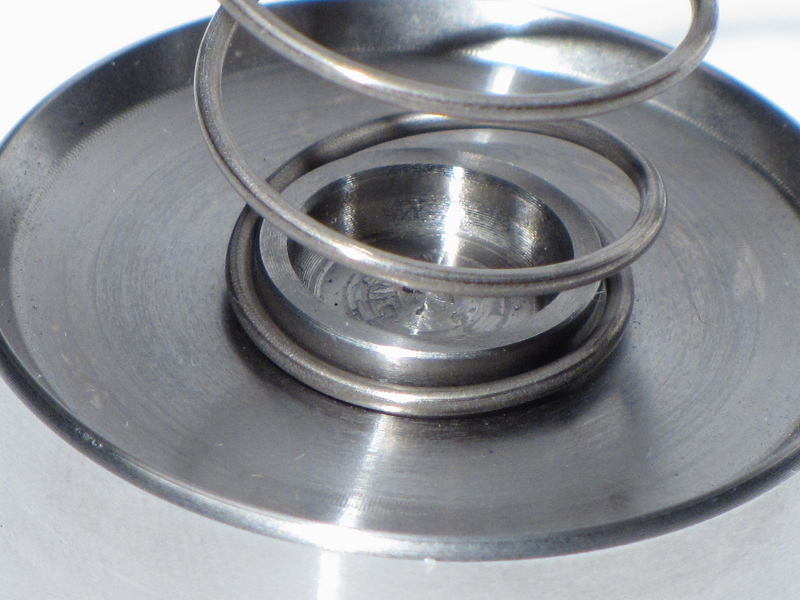
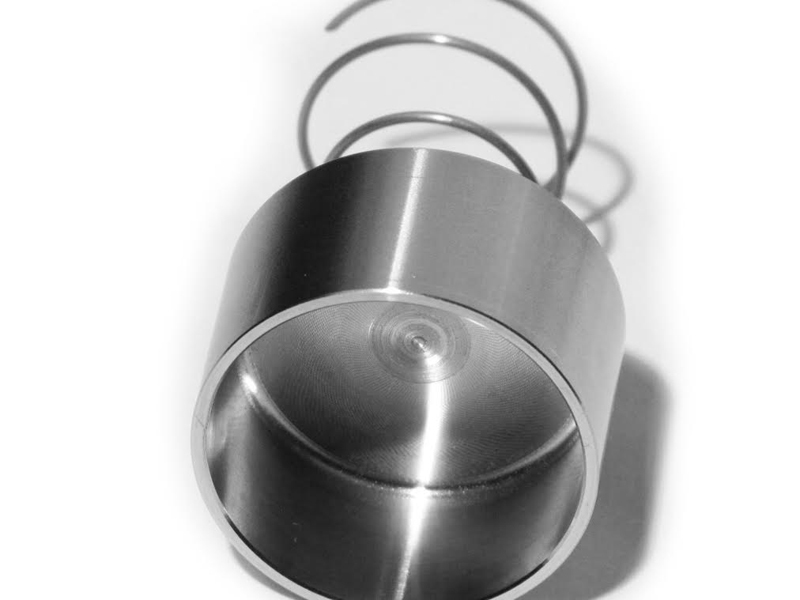
High Temperature, Low Drag Seals Without Dust Boots
We are often asked by potential customers if the calipers in our kits need frequent maintenance and rebuilding because the pistons don't have dust boots. We are perpetually stunned by this question because it makes no intuitive sense. If you have a product that is specifically designed to handle the extraordinary high-heat conditions of track use, why would it require more maintenance when used under those conditions vs. brake components that were designed to cruise around on the streets at low speed and temperature?
Many people confuse piston seals with dust boots. All calipers have seals. They're the little rubbery rings inside the piston bores (see pic below). If a caliper didn't have a seal, your brake fluid would leak out around the pistons! OEM caliper seals aren’t designed to handle constant trips to several hundred degrees without becoming brittle and leaking. Our calipers use special high-temp seals designed for track use. They are the exact same high temperature seals used in NASCAR Sprint Cup, ALMS, DTM, etc. That means they are less likely to get brittle and wear out when used under high-heat track conditions, and they need far LESS frequent replacement and servicing.
Most aftermarket calipers are designed for year round road use, and as such come with a bellows style external dust boot like the ones shown below. The rubber boot stretches as the piston extends, and its objective is to keep contaminants out of the piston bore. It's a nice concept, but we've seen customers burn those up in a single 20 minute track session! Once that happens, you're simply driving around with some tattered, burnt rubber bits attached to your pistons. At that point they're providing zero benefits to you. If you're going to immediately destroy them when you go to the track, why worry about having them in the first place? We skip making that mess for you by removing them from our design.
AP Racing High-Temp Piston Seal
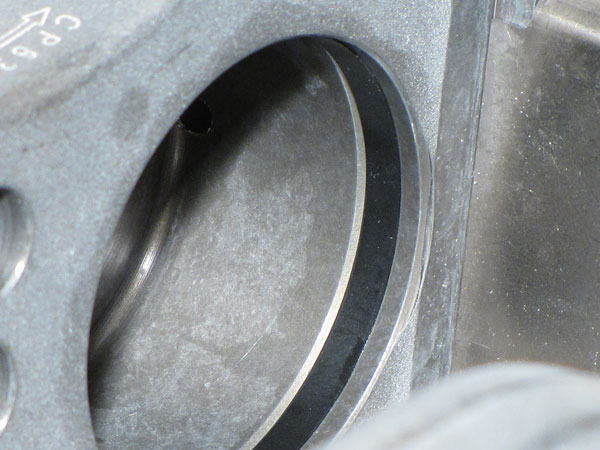
OEM Dust Boot Before Track Use
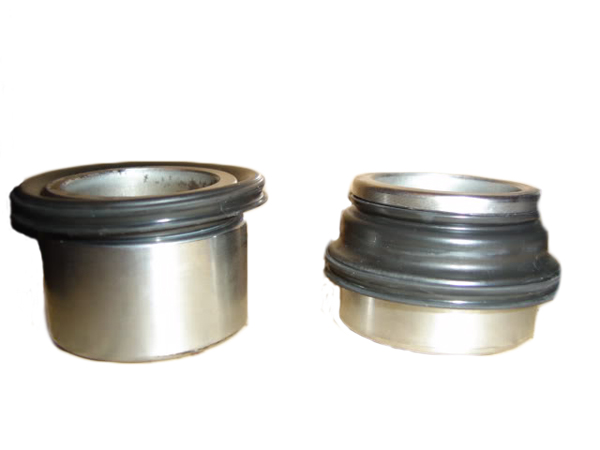
OEM Dust Boot After Track Use
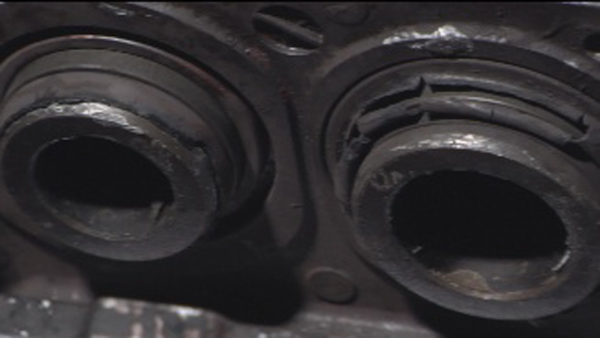
Simple Pad Change with One Bolt
After the countless times you’ve altered your brake pads, you’re probably never too thrilled when it comes time to do so. Changing pads will no longer be a chore. No more fiddling with a hammer, punch, or pliers. AP’s bridge bolts pop out easily with a 5mm hex wrench and a 7mm socket. It will take you longer to pull off the wheel than it will to change pads. Less time futzing around in the paddock, and more time driving= fun.
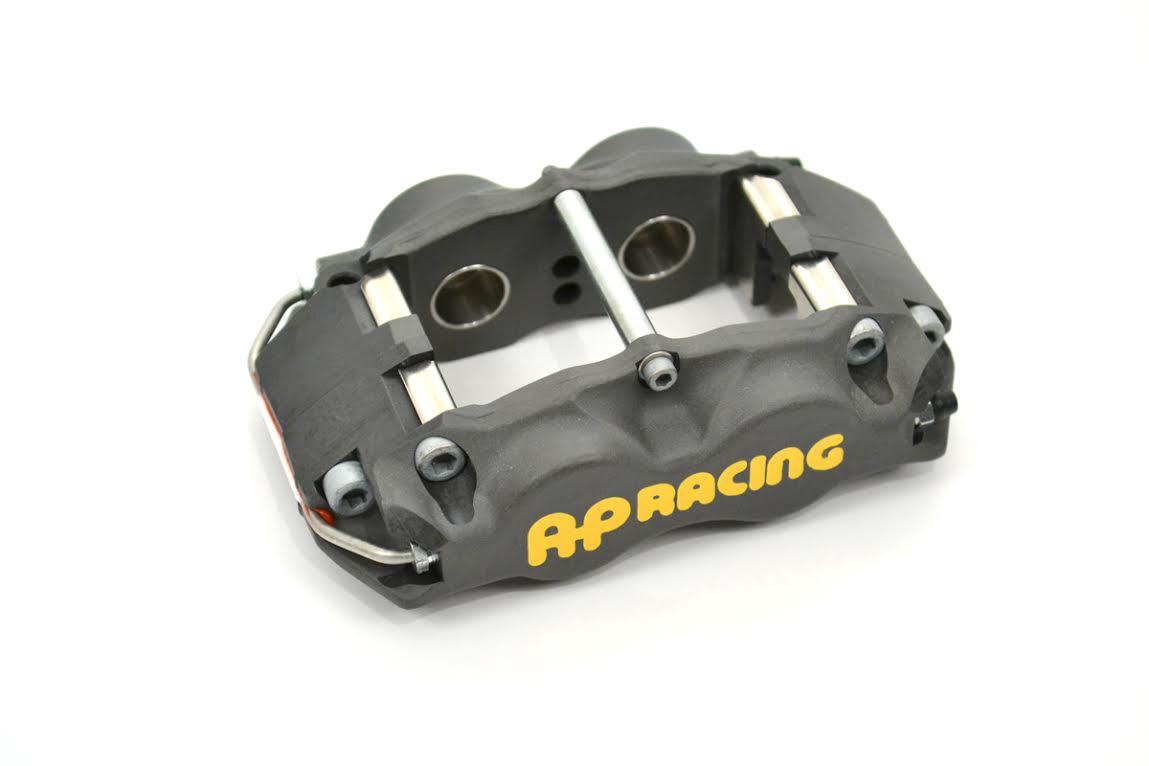
Pistons Sized Specifically for Your Car
The piston sizes in our systems are specifically chosen to closely mimic the OEM brake torque on a given axle. As such, our front systems can be bolted to otherwise stock cars with no ill-effects, negative impact on ABS, etc. The vehicles stock master cylinder can remain, as can the OEM rear brake system.
Integrated Bleed Screw and Crossover Tube Protection
How often do you take the wheels on and off of your track car? At least once per event? A 30lb. wheel and tire combo can do quite a chunk of damage when it collides with a caliper's bleed screw or crossover tube. Of the hydraulic components shown below, which do you think have better impact protection?
The CP8350's body was designed to protect the bleed screws and crossover piping from heavy-handed crew members and track debris. These delicate hydraulic components reside in small coves on the caliper body that can resist the impact of a wheel, tool, rock, etc. Wheel, pad, and fluid changes become less worrisome and faster, and less time in the pits equals more time on the track.
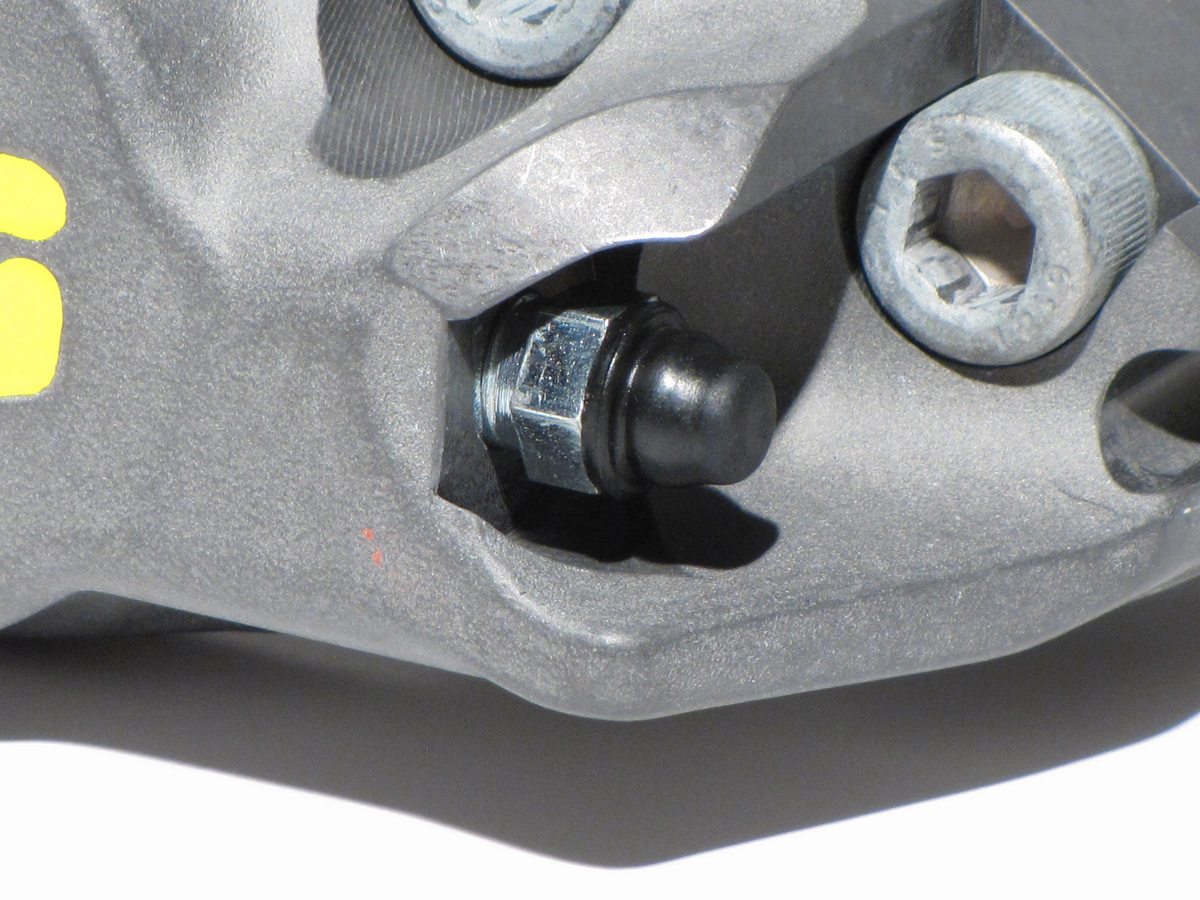
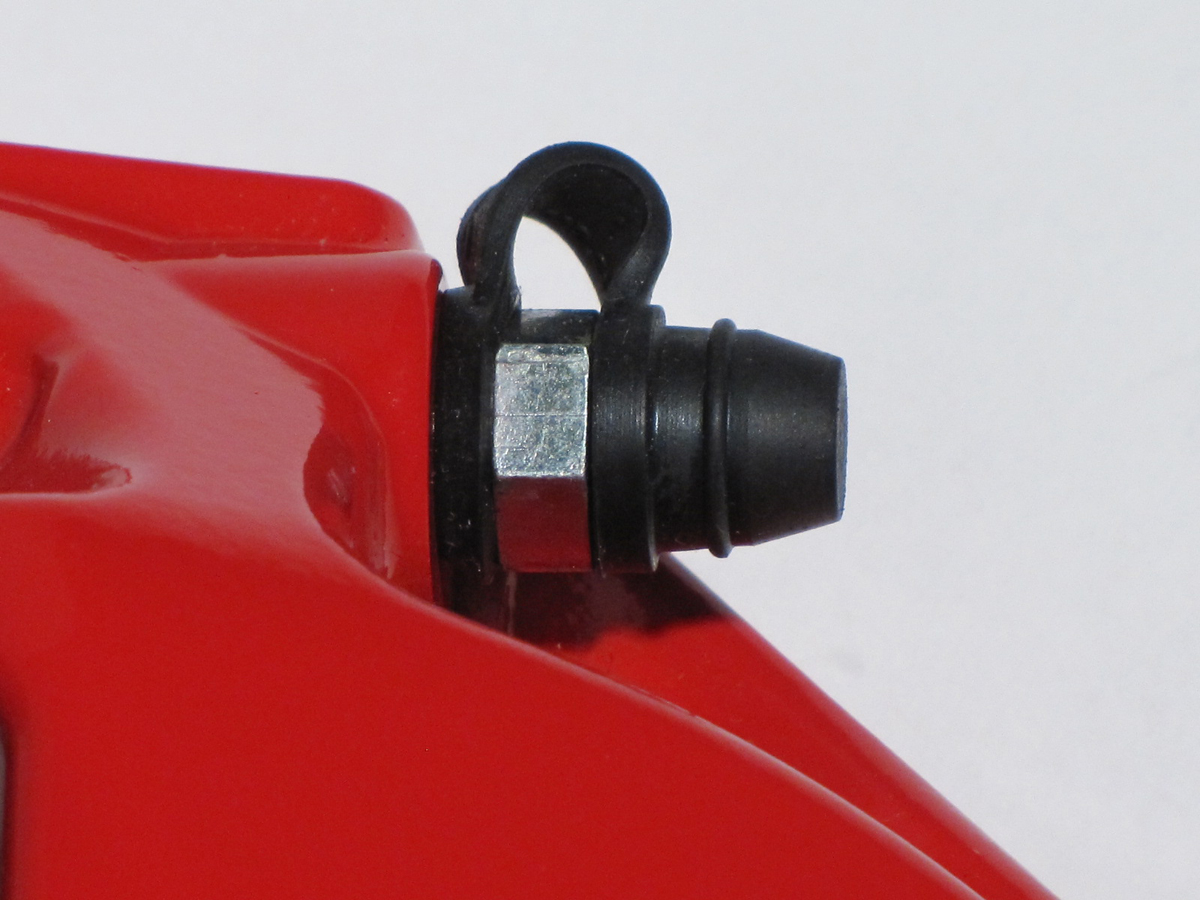
Ultra-lightweight, Compact Design
The Essex mantra when designing brake kits has always been, "Anything larger than necessary to get the job done is simply dead weight to drag around," and the CP8350 aligns superbly with those values. One of the crucial difficulties with many of the brake packages currently on the market is wheel fitment. You’re offered gigantic discs and 12 piston calipers, with a pat on the back and a, “Good luck finding wheels to clear those things (insert sinister chuckle here).” The reality is that many casual racers want to use their OEM wheels on the track, or the smallest, lightest wheel they can find. Not only is saving unsprung weight critical, R compound tires are much more plentiful and cheaper for smaller wheels. If the components are designed properly with heavy use in mind, you don’t need to cram boat anchors under your wheels. If you’re uneasy about the loss of stiffness due to mass reduction, don’t. Some manufacturers use a heavier six piston caliper, but that's because the caliper wasn't designed or optimized for racing. In those cases, the same caliper may have been designed for use on much heavier road cars, and even trucks! AP Racing’s CP8350 calipers are incredibly stiff, and designed from scratch with only the racetrack in mind.
Lifetime Professional Reconditioning Service
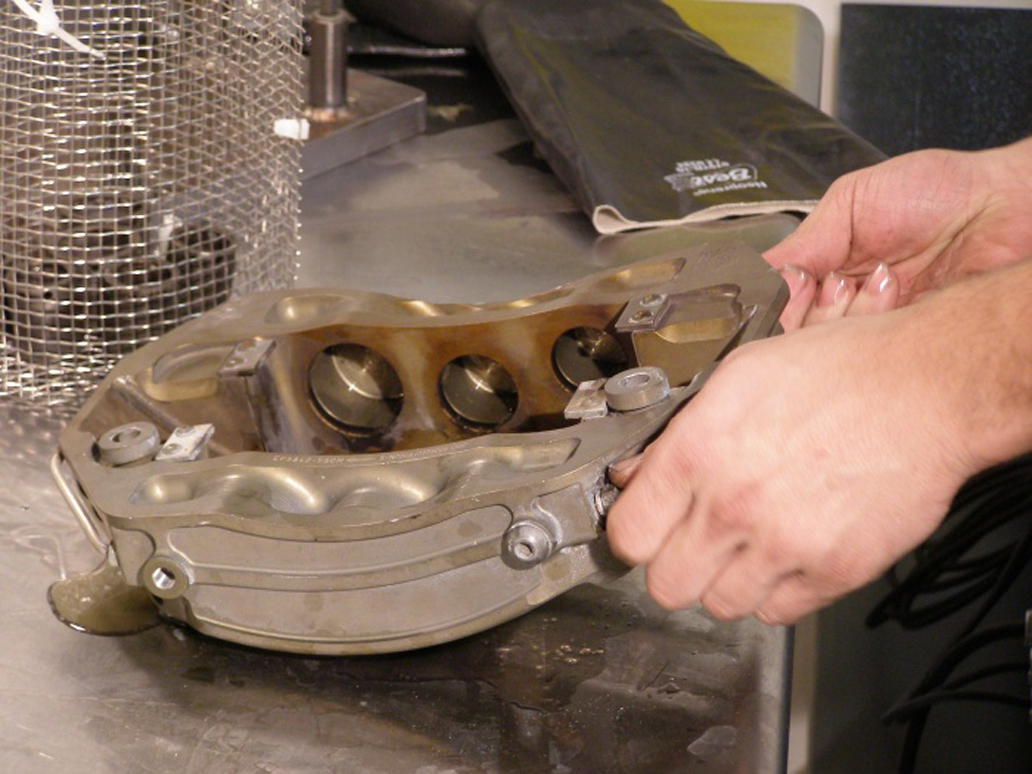
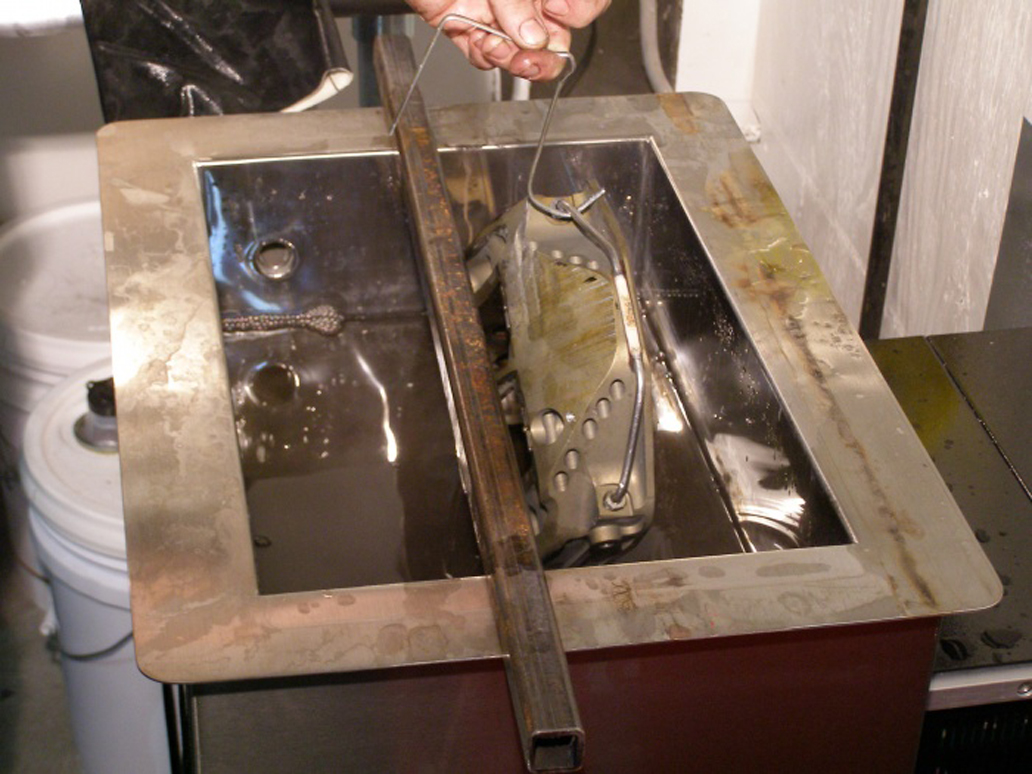
Essex is AP Racing's official North American caliper reconditioning center. We have skilled service technicians rebuilding hundreds of AP Racing calipers each year for the top teams in NASCAR Sprint Cup, ALMS, etc. As an Essex customer, our rebuild service will always be accessible to you when your calipers need servicing. You merely remove your calipers from the car, drain/clean them, and ship them back to Essex. We take it from there:
Hardness testing: After disassembly your calipers will be Rockwell hardness tested against the standard for that particular caliper type as sold new. This test gives a relative comprehension of how much fatigue and stiffness loss your calipers have experienced. Tired calipers lead to pad tapering, increased pad wear, leaky seals, and a loss of pedal firmness, all things you want to avoid. Essex will make a replace or rebuild recommendation based on the results of this test.
Ultrasonic cleaning: After passing the hardness test, your calipers will be placed in an ultrasonic cleaner to remove all dirt, debris, brake fluid, etc. This method produces results that are far superior to what the average racer could accomplish via hand-cleaning.
Inspection and re-assembly: All serviceable parts of the caliper will be inspected and replaced if necessary, including the seals, abutment plates, pistons, and bleed screws.
Cyclical Pressure Testing: After your calipers have been rebuilt, they will be cycled at high and low pressure on a pressure bench to ensure proper functioning. This is significant, as certain leaks only show up under specific pressure conditions.
Price: The labor price to rebuild is roughly $80 per caliper. That does not include parts. Assuming there has been no damage to the caliper, Essex typically recommends replacing the seals ($60) and bleed screws ($15) during the standard reconditioning process. For roughly $160, you can have a fresh, professionally serviced caliper in peak operating condition. You won't get messy, and you'll know the rebuild was done by the same folks trusted by elite-level race teams.
DISCS- AP RACING COMPETITION J HOOK
The AP Racing J Hook discs in our system are the epitome of endurance racing components. They will hold up exceptionally well to any abuse you plan to throw at them. These discs have been proven time and again in professional racing, winning many races and even championships (ALMS, Rolex, Grand Am, etc.)
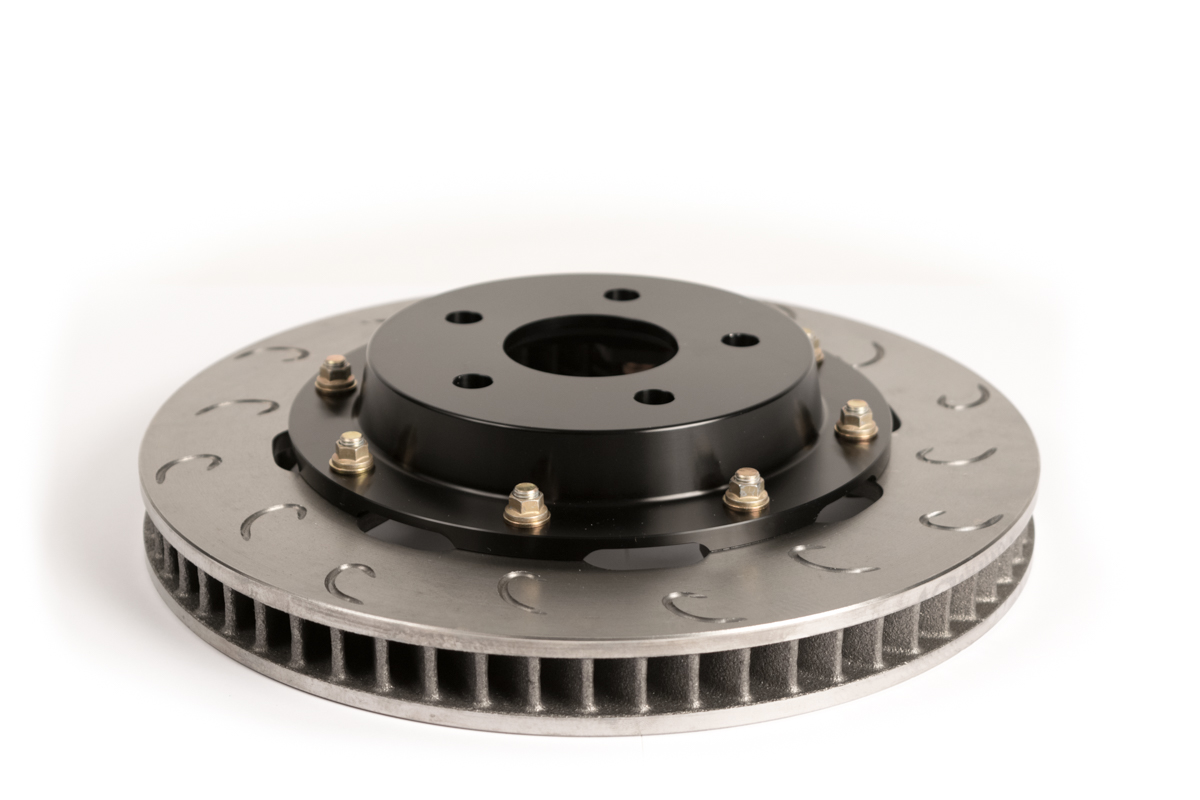
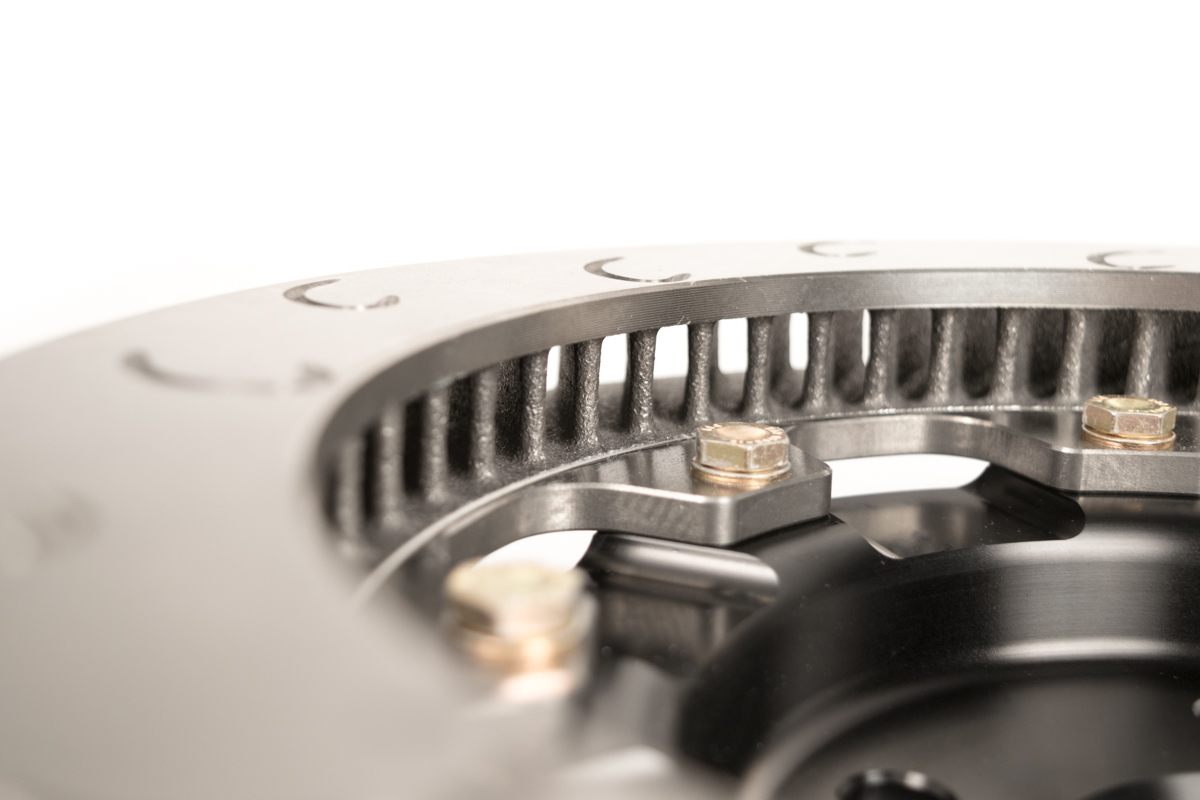
Internal Vane Quantity and Quality
The internal vane design on AP J Hook discs is quite a bit different vs. OEM-style discs and other brands of aftermarket discs. Many OEM discs feature a pillar vane design, which can be thought of as a group of posts or pillars connecting the two disc halves together (see pic below). The pillars are not organized linearly from the outside to the inside of the disc, and turbulence is created as air flows through and among them. Pillar vane discs are therefore not particularly well suited to heat evacuation. The goals of a pillar vane design are disc face stability for low NVH (Noise, Vibration, Harshness), and a low cost of production. Pillar vanes are non-directional, and the same part number is used on both sides of the car (again for cost reduction). Other OEM discs feature a straight, non-directional internal vane. While that type of vane flows more air than a pillar, it does not move nearly as much air as the directional vanes featured in AP Racing's discs. Having directional vanes means that AP Racing discs are handed. There is a unique left disc and a right disc in each pair, and they cannot be swapped from side-to-side on the car. The orientation of the vanes is optimized to spin in a certain direction, pumping the greatest amount of air possible through the disc. The shape of these internal vanes is also optimized to promote smooth airflow.
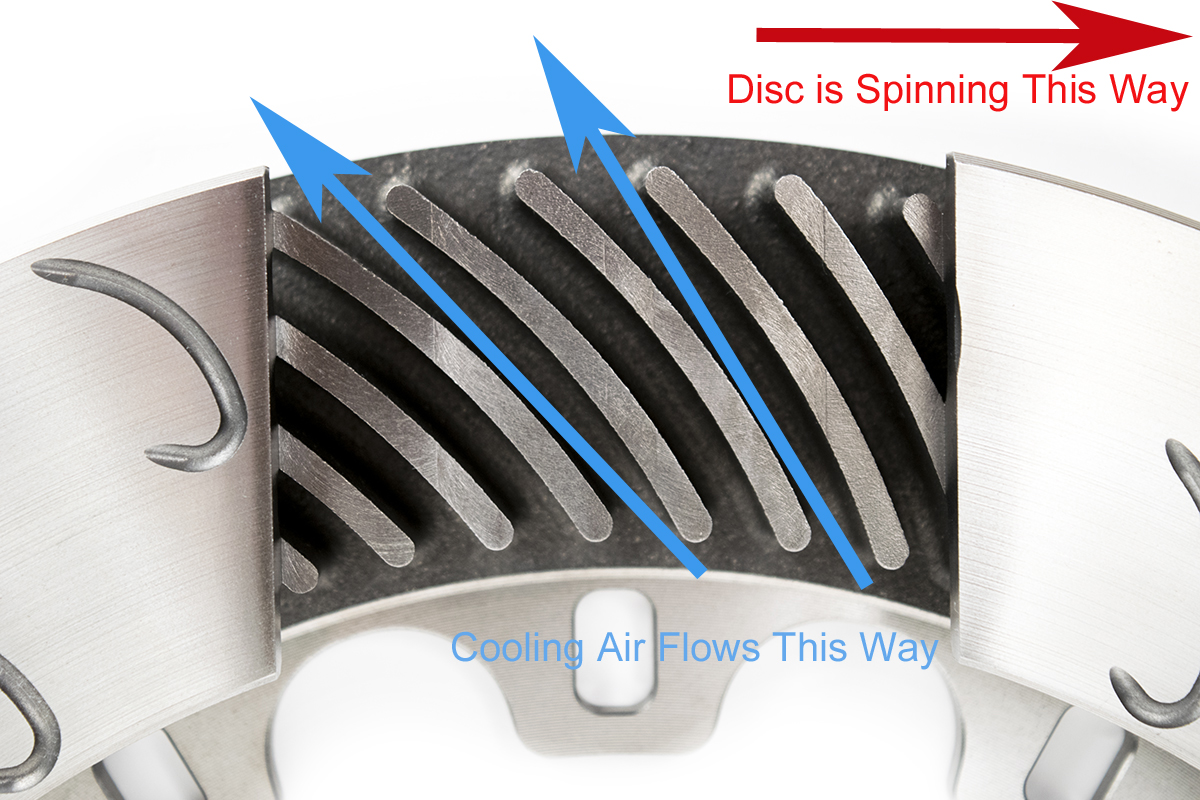
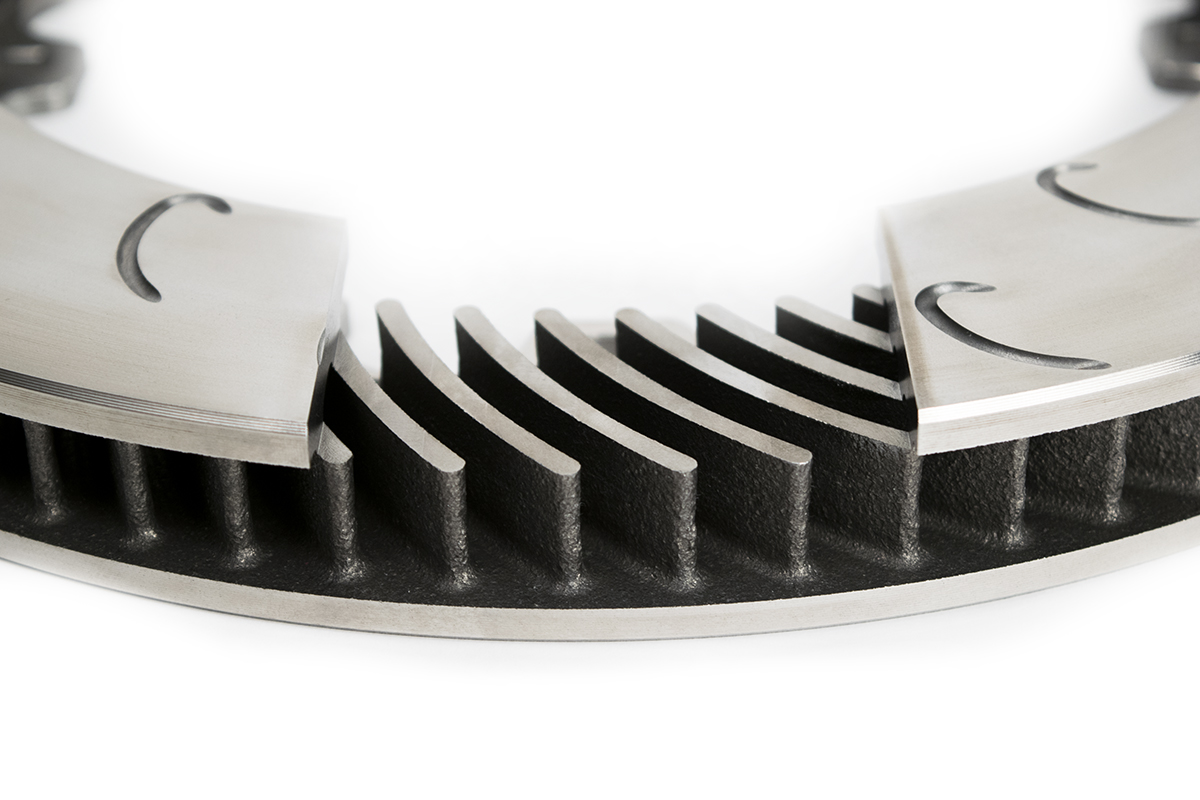
In addition to having a superior internal vane design, AP Racing discs have far more of them! Most aftermarket discs have 30 to 48 vanes. After extensive CFD and thermal stress analysis, AP designed the J Hook's with a high vane count (typically 60 to 84 depending on application). Having more vanes increases airspeed and heat transfer through the disc, reduces air recirculation between vanes, and reduces deflection at the disc face. Compared to an OEM-style disc or competitor's 48 vane discs, the 60+ vane discs are less prone to coning, distortion, and cracking, while providing less brake fade, reduced judder, more even pad contact, and a longer service life.
Below is a comparison of a one-piece OEM pillar vane disc and an AP Racing two-piece J Hook. A few things to note in these pictures: The AP Racing disc has a much wider air gap between the disc faces, allowing considerably more airflow into and through the disc. The uniform, directional vane design also contributes heavily to superior airflow.
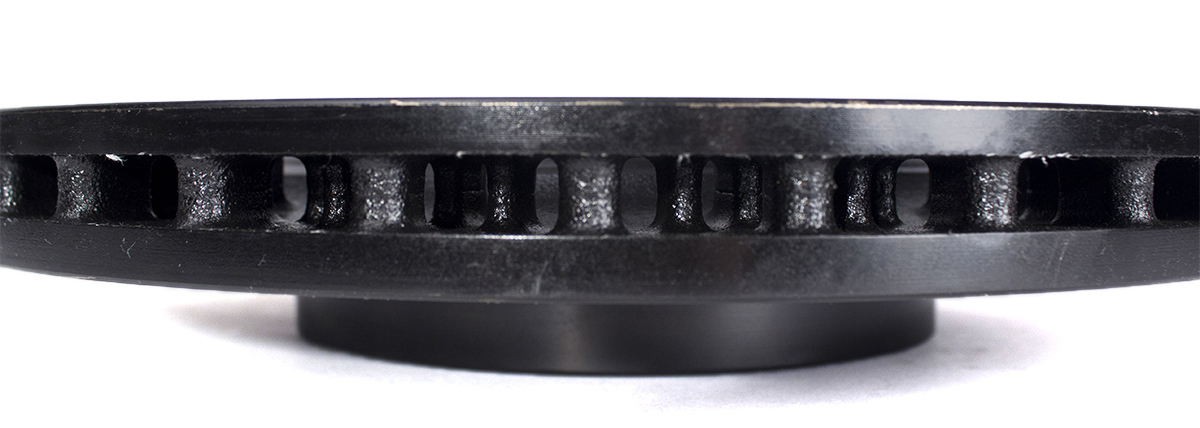

Most of the cooling air that enters a brake disc comes from the back side of the discs, particularly if brake ducts are being employed. The top disc is an OEM pillar vane. The second disc is an OEM dual-cast disc (which is technically a two-piece disc). The bottom disc is the AP Racing J Hook. Which of these discs do you think will flow the most air? While the OEM discs have narrow inlet port and/or obstructions blocking the disc vanes, the AP Racing disc offers a clear path for cooling air to enter and flow through the disc. The result is significantly cooler discs that are less prone to cracking and wear.



Lightweight, Billet Aluminum Hat Design
The disc hats are manufactured from lightweight 6061 heat-treated billet aluminum, with a hard anodized coating. This material was specifically chosen for its strength at high temperatures, as it will be in direct contact with the searing hot iron discs. The hats feature scallops on the underside, to allow for heat evacuation along the outer disc face once installed. The discs also have the added benefit of reducing heat conduction to the hubs and bearings, decreasing wear and tear on these costly components.
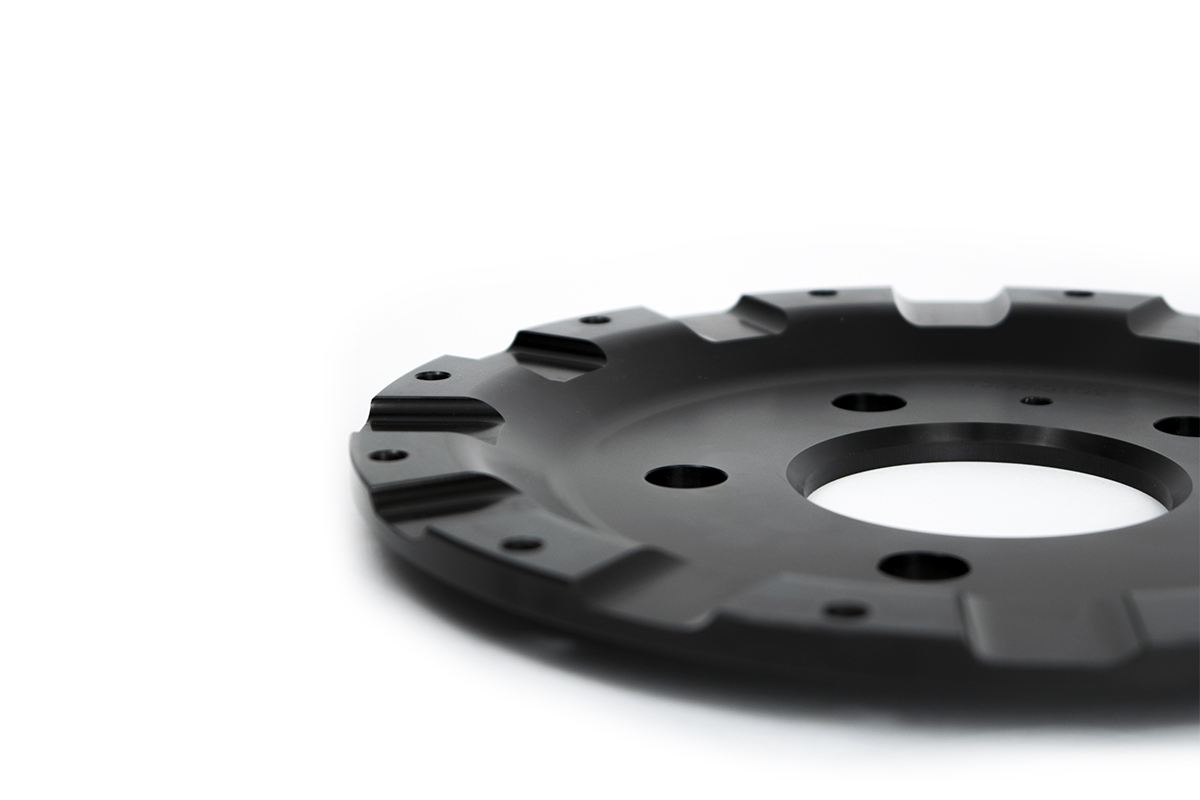
Exclusive AP Racing J Hook Slot Pattern
When you cut a slot or drill a hole in a disc you impact heat transfer. The area around the slot or hole acts as a cool spot when the disc heats up, which is not ideal. Ideally, heat is distributed uniformly around the disc so it can be hit with the cooling air that is pumping through the disc, radiate outwards away from the disc, etc. Cool spots create stress risers and increase the likelihood of the disc cracking. They also cause the face of the disc to distort unevenly, leading to uneven pad deposits, vibration, and judder.
The OEM discs avoid this problem by simply leaving the face blank. While the risk for NVH goes down, so does the pad bite and feel of the disc through the brake pedal. Competitive aftermarket offerings typically have straight slots, which tend to leave cool spots across the disc face between the slots.
During exhaustive R&D testing, AP's J Hook design was found to create a constant pathway of evenly distorted material on the face of the disc. The hooks are spaced out as evenly as possible both around the circumference of the disc, as well as from the inside edge (where the hat attaches) to outer edge, with a slight overlap to promote even heat distribution/distortion. In addition to reducing cracking, the even heating of the disc also helps provide an even transfer layer of pad material on the disc when you bed them in.
Additionally, the J Hook slot pattern produces a greater number of leading edges for the pads to bite into vs. a traditional curved slot pattern, and particularly a plain-faced disc. While this may lead to slightly more whirring or scraping noises from the discs when applying the brakes, the benefits of more even heat distribution, less propensity to crack, cleaner pad material transfer during bed-in, and more bite far outweigh the slight increase in NVH for the serious enthusiast.
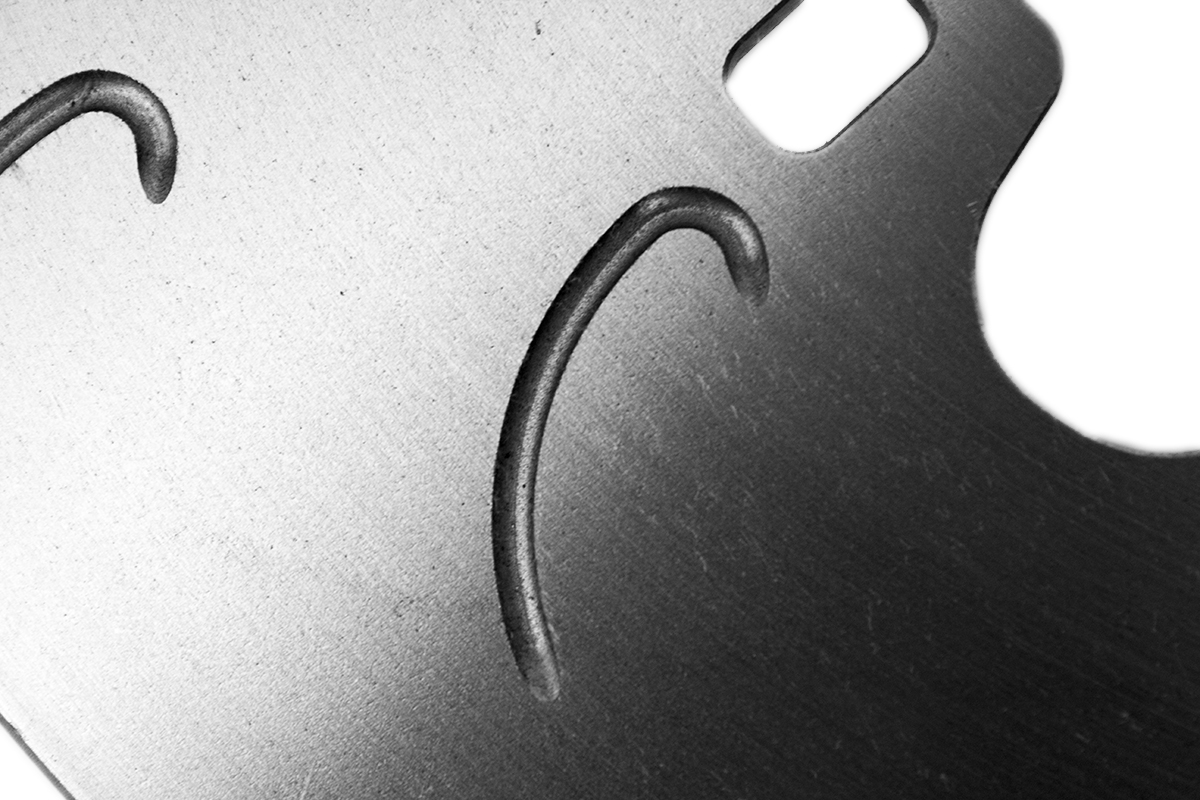
Complex Metallurgy Developed Through 50+ Years of Experience
AP Racing has been designing brake components for more than 50 years. They've had their components on cars that have won more than 750 Formula 1 races! On any given race weekend, AP J Hook discs can be found on 75% or more of the NASCAR Sprint Cup grid. AP has learned from these experiences, and have developed a proprietary iron alloy with extreme durability, designed specifically for what you intend to do with it (flog the hell out of it). The primary objectives with OEM discs are simple: they must be cheap and easy to produce. The design objectives for these two products are vastly different.
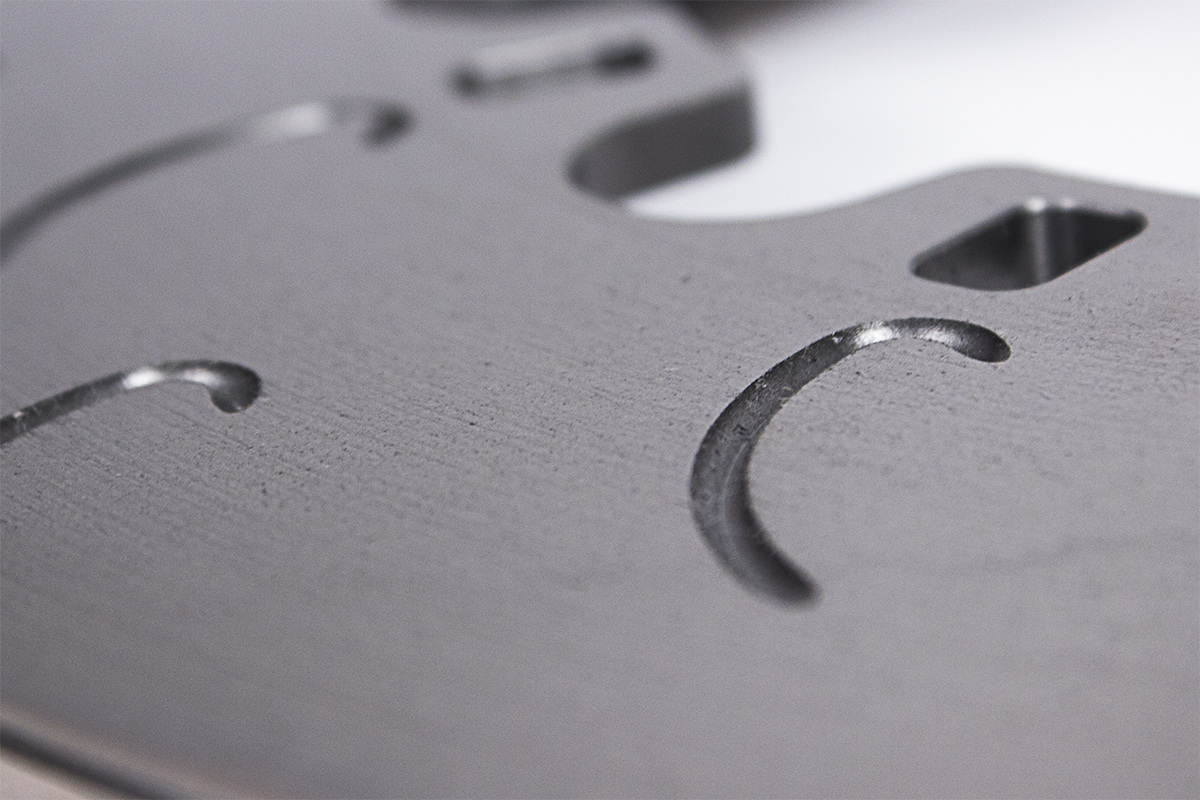
Disc Burnishing/Bedding Service
If your brake discs aren’t being properly prepared for abuse prior to flogging them on track, you’re exposing yourself to potential judder, vibration, and cracking issues. We all know that prepping your pads and discs at the track can be difficult. Doing so wastes time during the first session of the day, and it's a hassle and potentially dangerous for other drivers as you go through the procedure. Track time is expensive and tough to come by. The more time you spend behind the wheel performing an elaborate bed-in procedure, the less time you’ll spend doing hot laps. Performing the procedure on-track also limits its repeatability. You can't control what's going on around you with track conditions, other drivers, etc., and many track configurations don't really lend themselves to the constant start/stop/start required to do the job properly.
Essex is now offering a solution via our professional burnishing service. Previously reserved for our professional racing customers, we are now offering our retail customers the option of having the discs in select Competition Brake Kits pre-burnished at our factory. We burnish thousands of discs for the top racing teams each year. After countless hours of experimentation, and extensive feedback from the top drivers and teams, we can consistently squeeze the most reliable performance out of AP Racing's discs. The procedure is incredibly repeatable, as it is performed on a computer-controlled machine by experienced technicians. The cost of our burnishing service is $50 per disc ($100 per brake kit).
Please note that the pads you receive will not be pre-burnished. In other words, the pads and discs do not have to be a matched set burnished together to reap the benefits the procedure has on the discs. In other words, we will burnish the discs in the pad compound you choose, they just won't be burnished with the exact set of pads that will arrive with your kit.
Watch a brief video of our disc burnishing service here.
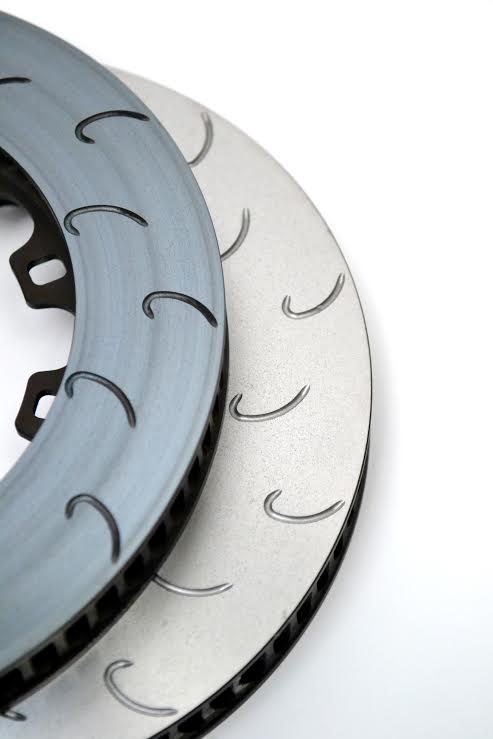
Reasonable Replacement Cost
Let's face it, no matter how good a brake disc is, it's still a consumable item. They're no different than brake pads or gasoline. You beat them up until they crack to pieces, then you throw them away. If replacement iron is too expensive, you're always driving in fear, waiting to shell out big bucks for a new set. Despite having the most expansive set of features on the market, spare AP Racing J Hook's are completely affordable.
Going to the track is expensive! Event entrance fees, hotels, fuel, and tires all add up. While you obviously want the best product available, you can't afford to pay a small fortune for something you're just going to destroy. You can buy a cheap set of discs for every event, have relentless heat issues, and find yourself constantly swapping them out. When you do the math, the long-term value of the AP J Hook's is tough to beat. You'll enjoy all the benefits without breaking the bank, and you'll spend more time driving and less time wrenching.
Elite level teams choose AP Racing discs because they know the work has been done to provide the best available product at any price level. The AP J Hook is a direct derivative of AP's vast racing experience. You can buy with confidence knowing that you're getting the best product available at any price point. A note of caution however: the J Hook design is often imitated, and there are a number of lesser quality imitations on market. Before purchasing, make sure you are getting an authentic AP Racing J Hook.
Caliper Brackets & Hardware
Caliper brackets for our kit are machined from heat-treated 6061 T6 billet aluminum, and hard anodized, ensuring strength and durability. All included hardware is of aircraft quality, and identical to what we use in professional racing. One of the nice features of our brackets is their cutaway design, which allows for the snug fitment of many currently available brake duct kits.
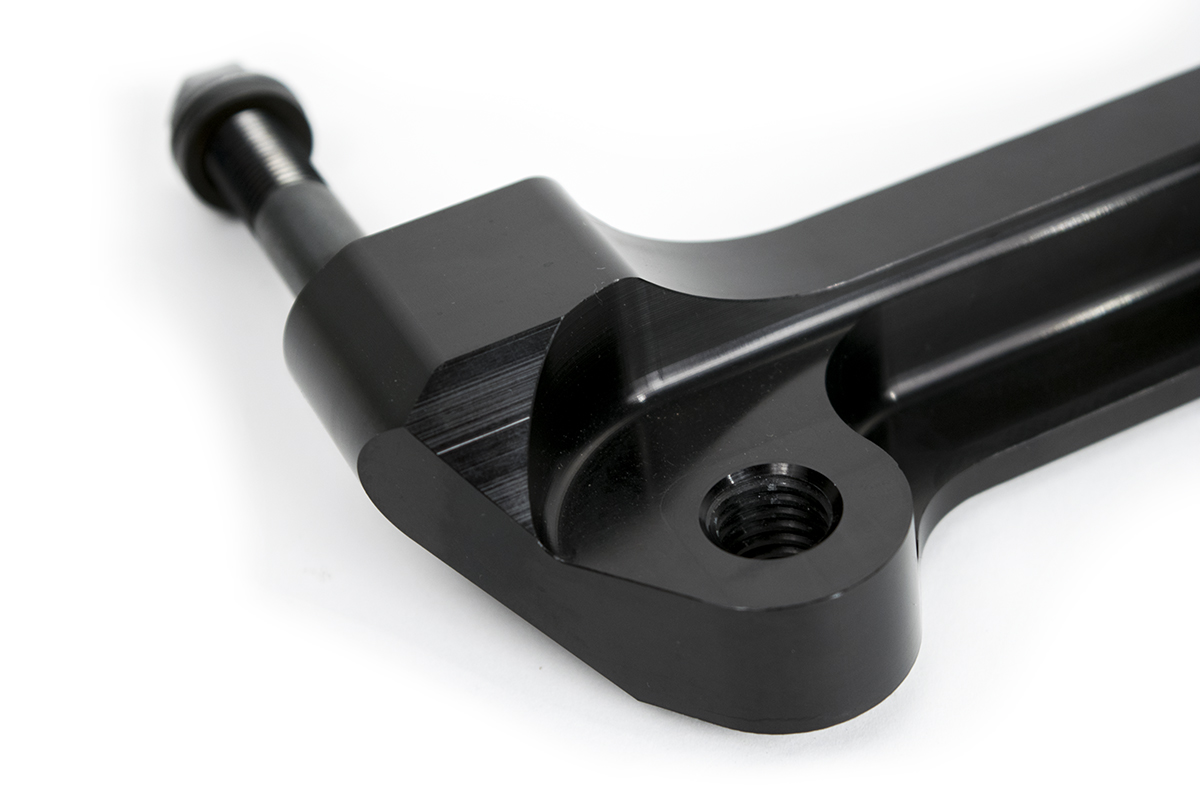
Brake Ducting
Essex does not recommend aftermarket brake ducts with our Competition Brake Kits. In our experience, packaging issues make it nearly impossible to pipe an adequate amount of cooling air from the nose of the car into the center of the discs. The duct hoses are typically too narrow, and there isn't enough room for properly-sized hoses to clear the tire in the fender well. Many systems also direct cooling air to the incorrect location, which can create uneven cooling and temperature gradients throughout the disc, which leads to premature cracking. Finally, the plates used to attach brake ducts at the wheel hub frequently trap heat against the inner disc face, creating a systemic temperature increase. As such, we do not recommend aftermarket brake ducts.
If your vehicle has an OEM brake duct that dumps air into the wheel well, and or a series of air deflectors inside the wheel, it is fine to leave them installed. If you have installed your Essex Designed AP Racing Competition Brake Kit, collected data, and believe it is running hotter than expected, please contact us to discuss your options.
Please also note, DO NOT BOLT ANYTHING BETWEEN THE CALIPER BRACKET AND THE SUSPENSION UPRIGHT! Any ears or tabs from a brake duct system bolted between the bracket and the upright will malign the caliper from its intended orientation, causing potentially serious damage to the entire brake system or car. The bracket should be directly bolted to the upright as intended, with nothing sandwiched between the two.
Spiegler Stainless Steel Brake Lines
Our Competition Kits include a set of the highest quality stainless steel brake lines available. Spiegler lines have a wide range of features not available in competitive offerings. Below are just a few. For complete details please visit the Spiegler page on our site.
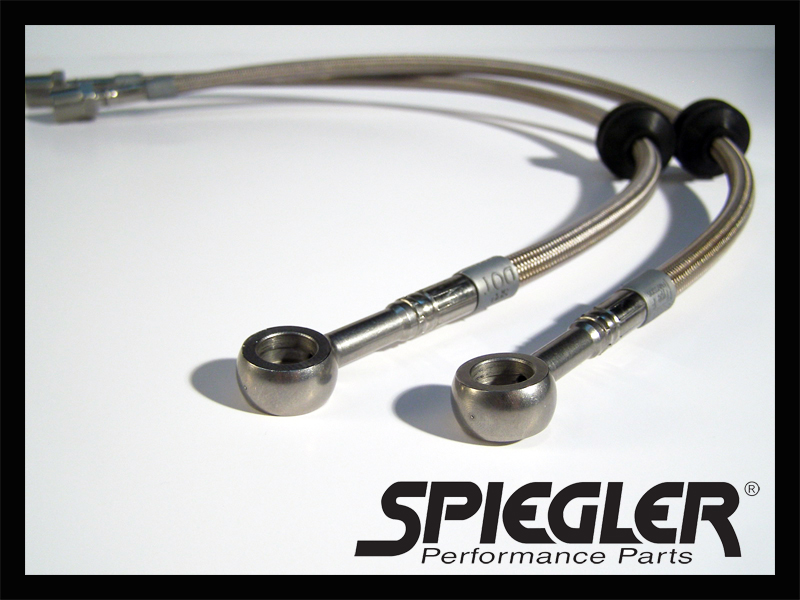
|
Feature |
Benefit |
|
All components manufactured in USA and Europe |
Stringent and consistent quality control |
|
Stress-free Torsion Fitting System |
Allows 360 degree rotation of banjo fitting for correct alignment and strain reduction |
|
Abrasion resistant coating/sheath |
Eliminates snagging and chafing |
|
Aircraft quality stainless steel fittings and bolts |
Superior strength, longevity, and safety |
|
Heavy gauge, tightly woven stainless steel braid |
Eliminates line swell, more consistent feel |
|
Du Pont PTFE- Teflon® lining |
Reduces line expansion and provides greater durability |
|
DOT compliant |
Quality assurance, road legal |
|
Wide range of colors |
Allows for personalization |
|
Standard and custom designs shipped in 48 hours |
No more waiting around for lines to show up |
|
Full testing battery on all parts, with lifetime warranty |
Purchase and drive with confidence |
Endurance vs. Sprint System Comparison
- Sprint system is roughly 10 lbs. lighter per corner than stock, while Endurance system is approximately 5 lbs. lighter per corner than stock
- Endurance system uses slightly larger disc, with a higher internal vane count
- Aluminum hats on Endurance discs are floating, while hats on Sprint discs are bolted
- Actual disc metallurgy the same for both kits, although spare discs for Sprint system are about $100 cheaper (each)...$200 less for the pair.
- Slightly taller pads can be used on the Endurance package, giving greater pad volume and longer wear characteristics
- Any pad that works in the Sprint System will also work in the Endurance package
- Both kits will fit under certain 17" wheels, but neither will fit OEM wheels without a spacer. Wheel fitment templates available on our site.
Differences are in bold below:
|
Essex FT86 Competition Brake System Comparison Grid |
|
|
Sprint System |
|
|
$2,899.00 |
$2,299.00 |
|
Total system weight savings vs. OEM= 10 lbs. |
Total system weight savings vs. OEM= 20 lbs. |
|
Weight savings per front corner vs. OEM= 5 lbs. |
Weight savings per front corner vs. OEM= 10 lbs. |
|
325mm x 32mm |
299mm x 32mm |
|
70 Directional Vanes |
60 Directional Vanes |
|
J Hook Slot Pattern |
J Hook Slot Pattern |
|
Fully floating |
Fixed mount |
|
Crack-resistant metallurgy |
Crack-resistant metallurgy |
|
Approximate weight with hat= 17.6 lbs. |
Approximate weight with hat= 12.2 lbs. |
|
Spares Price= $249 per iron replacement disc |
Spares Price= $158 per iron replacement disc |
|
Brake pad maximum radial depth 50mm |
Brake pad maximum radial depth 43mm |
With either of our systems, Essex recommends upgrading your rear brake pads to the same or similar pad compound to what you will be running in the front. Doing so will help provide the appropriate brake bias, ABS integration, and feel that our customers expect under heavy braking loads on the track.
If you have any fitment questions, please feel free to reach out to our team via the contact methods below. If you are contacting us for any order status updates, please give us a call, or email us. We are a lean operation bringing you the best shopping experience possible. We are working on your orders as quickly as we can. We thank you for your patience.
- Call:
- Please reach out to us at (310) 231-0292 for sales inquiries if you are in the United States, Canada, Mexico.
- Email:
- For more in-depth product questions, fitment questions, product inquiries please email our performance specialists at online@autotalent.com.
- All other inquiries:
- Please direct your inquiries to the chat functionality on our website.
Returns Policy
If a product is ordered and not wanted, the UNUSED item can be returned for a 25% restocking fee unless otherwise specified. In some cases, we may offer the ability to return the item to us for a lesser restocking fee and then keep the balance as a store credit. To return an item, it must be in brand new condition with original packaging.
We cannot accept a return on special ordered or custom items.
Shipping is non refundable in either direction unless approved by AutoTalent. All items wanting to be return MUST be reported within 30 days of the original invoice date. No items will be returnable after 30 days. All products shipped from the AutoTalent facility are shipped via FedEx, USPS, or USPS. Some packages shipped from the manufacturer may or may not require signatures for package release.
Special Order Items
Some items may be special order specifically for the customer’s vehicle. These items generally require a deposit or paid in full. Once this deposit amount is notified to the customer and they agree to order the special order item, the deposit becomes non-refundable. These special order items cannot be returned or resold. Cancellations are not allowed on special order parts.
AutoTalent DOES NOT REFUND SHIPPING CHARGES. If you modify, install, or alter the item in any form, we cannot accept it as a return. We will not cover any expenses related to the product or installation, and you may be required to purchase a replacement.
** All cancellations that are requested that are NOT due to items not being in stock or delayed by the manufacturer are subject to a 5% processing fee. When you place an order with us we pay credit card fees that are NOT returned back to us. We will absorb these fees if we do not have the item in stock OR if you agree to the original ETA and that ETA is NOT met. If you decide to cancel for any other reason you will not receive this 5% fee back
Shipping
We can ship to virtually any address in the world. Note that there are restrictions on some products, and some products cannot be shipped to international destinations.
When you place an order, we will estimate shipping and delivery dates for you based on the availability of your items and the shipping options you choose. Depending on the shipping provider you choose, shipping date estimates may appear on the shipping quotes page.
Please also note that the shipping rates for many items we sell are weight-based.
Others People Also Bought
- Regular price
- From $2,499.00
- Regular price
-
- Sale price
- From $2,499.00
- Unit price
- per
- Regular price
- From $2,499.00
- Regular price
-
- Sale price
- From $2,499.00
- Unit price
- per
- Regular price
- From $2,499.00
- Regular price
-
- Sale price
- From $2,499.00
- Unit price
- per
- Regular price
- From $2,499.00
- Regular price
-
- Sale price
- From $2,499.00
- Unit price
- per
- Regular price
- From $2,499.00
- Regular price
-
- Sale price
- From $2,499.00
- Unit price
- per
- Regular price
- From $2,499.00
- Regular price
-
- Sale price
- From $2,499.00
- Unit price
- per
- Regular price
- From $2,499.00
- Regular price
-
- Sale price
- From $2,499.00
- Unit price
- per
- Regular price
- From $2,499.00
- Regular price
-
- Sale price
- From $2,499.00
- Unit price
- per
- Regular price
- From $2,499.00
- Regular price
-
- Sale price
- From $2,499.00
- Unit price
- per
- Regular price
- From $2,499.00
- Regular price
-
- Sale price
- From $2,499.00
- Unit price
- per
- Choosing a selection results in a full page refresh.

